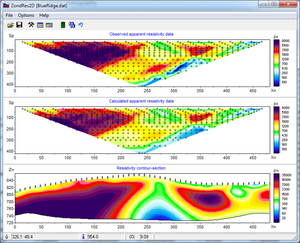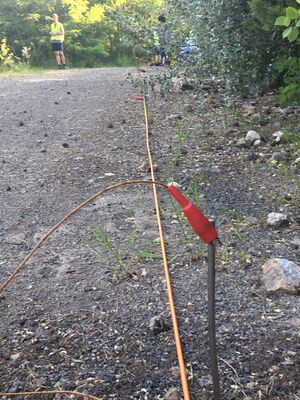التصوير المقطعي بالمقاومية الكهربائية
Electrical resistivity tomography (ERT) or electrical resistivity imaging (ERI) is a geophysical technique for imaging sub-surface structures from electrical resistivity measurements made at the surface, or by electrodes in one or more boreholes. If the electrodes are suspended in the boreholes, deeper sections can be investigated. It is closely related to the medical imaging technique electrical impedance tomography (EIT), and mathematically is the same inverse problem. In contrast to medical EIT, however, ERT is essentially a direct current method. A related geophysical method, induced polarization (or spectral induced polarization), measures the transient response and aims to determine the subsurface chargeability properties.
Electrical resistivity measurements can be used for identification and quantification of depth of groundwater, detection of clays, and measurement of groundwater conductivity.[1]
. . . . . . . . . . . . . . . . . . . . . . . . . . . . . . . . . . . . . . . . . . . . . . . . . . . . . . . . . . . . . . . . . . . . . . . . . . . . . . . . . . . . . . . . . . . . . . . . . . . . . . . . . . . . . . . . . . . . . . . . . . . . . . . . . . . . . . . . . . . . . . . . . . . . . . . . . . . . . . . . . . . . . . . .
التاريخ
The technique evolved from techniques of electrical prospecting that predate digital computers, where layers or anomalies were sought rather than images. Early work on the mathematical problem in the 1930s assumed a layered medium (see for example Langer, Slichter). Andrey Nikolayevich Tikhonov who is best known for his work on regularization of inverse problems also worked on this problem. He explains in detail how to solve the ERT problem in a simple case of 2-layered medium. During the 1940s, he collaborated with geophysicists and without the aid of computers they discovered large deposits of copper. As a result, they were awarded a State Prize of Soviet Union.
When adequate computers became widely available, the inverse problem of ERT could be solved numerically. The work of Loke and Barker at Birmingham University was among the first such solution and their approach is still widely used.
With the advancement in the field of Electrical Resistivity Tomography (ERT) from 1D to 2D and nowadays 3D, ERT has explored many fields. The applications of ERT include fault investigation, ground water table investigation, soil moisture content determination and many others. In industrial process imaging ERT can be used in a similar fashion to medical EIT, to image the distribution of conductivity in mixing vessels and pipes. In this context it is usually called Electrical Resistance Tomography, emphasising the quantity that is measured rather than imaged.
Operating procedure
Soil resistivity, measured in ohm-centimeters (Ω⋅cm), varies with moisture content and temperature changes. In general, an increase in soil moisture results in a reduction in soil resistivity. The pore fluid provides the only electrical path in sands, while both the pore fluid and the surface charged particles provide electrical paths in clays. Resistivities of wet fine-grained soils are generally much lower than those of wet coarse-grained soils. The difference in resistivity between a soil in a dry and in a saturated condition may be several orders of magnitude.[2]
The method of measuring subsurface resistivity involves placing four electrodes in the ground in a line at equal spacing, applying a measured AC current to the outer two electrodes, and measuring the AC voltage between the inner two electrodes. A measured resistance is calculated by dividing the measured voltage by the measured current. This resistance is then multiplied by a geometric factor that includes the spacing between each electrode to determine the apparent resistivity.
Electrode spacings of 0.75, 1.5, 3.0, 6.0, and 12.0 m are typically used for shallow depths (<10 m) of investigations. Greater electrode spacings of 1.5, 3.0, 6.0, 15.0, 30.0, 100.0, and 150.0 m are typically used for deeper investigations. The depth of investigation is typically less than the maximum electrode spacing. Water is introduced to the electrode holes as the electrodes are driven into the ground to improve electrical contact.
Applications
ERT is used to create images of various types of subsurface conditions and structures. It has applications in various fields, including:
Environmental Studies:
- Groundwater Exploration: ERT helps locate underground aquifers and assess water quality.
- Contaminant Mapping: ERT used to monitor and delineate the spread of contaminants in soil and groundwater.
- Landfill Monitoring: ERT monitors landfill conditions, gas generation and migration,[3] and leachate pathways.[4]
Geotechnical Engineering:
- Site Investigation: ERT is used to survey soil and rock properties and existing underground infrastructure in construction projects.[5]
- Foundation Assessment: ERT can evaluate the condition of foundations, detect voids, and assess load-bearing capacity.
- Sinkhole Detection: ERT can identify subsurface voids that may lead to sinkholes.
Archaeology and Cultural Heritage:
- Buried Archaeological Features: ERT can detect buried structures, artefacts, and archaeological sites.
- Structural Integrity of Monuments: ERT helps assess the condition of historic buildings and structures.[6]
Mining and Mineral Exploration:
- Mineral Deposits: ERT can delineate the boundaries and characteristics of ore bodies.
- Cave Detection: ERT is used to locate caves and karst features in mining areas.
Hydrogeology:
- Aquifer Mapping: ERT is employed to create detailed maps of subsurface aquifers and their properties.
- Saltwater Intrusion Monitoring: ERT helps detect and monitor the encroachment of saltwater into freshwater aquifers.
Engineering and Infrastructure:
- Tunnel and Dam Assessment: ERT assesses the structural integrity of tunnels and dams.[7]
- Pipeline and Cable Route Surveys: It helps identify subsurface utilities and potential hazards.[8]
- Landslide Hazard Assessment: ERT can detect subsurface slip planes and unstable slopes.
- Levee and Embankment Assessment: It assesses the structural integrity of levees and embankments.
- Building Health Inspections: ERT is used to examine the condition of foundations and other underground parts of buildings to guide upkeep and renovations.[9]
Oil and Gas Exploration:
- Reservoir Characterization: ERT assists in understanding subsurface reservoir properties.
- Monitoring Fluid Migration: ERT is used to track the movement of fluids in the subsurface during drilling and production.
Agriculture:
- Soil Moisture Mapping: ERT helps assess soil moisture content for precision agriculture.
- Root Zone Imaging: ERT is used to visualize plant root structures and soil-root interactions.
See also
- Electrical capacitance tomography
- Electrical impedance tomography
- Three-dimensional electrical capacitance tomography
- Magnetotellurics
- Seismo-electromagnetics
- Telluric current
- Vertical electrical sounding
- Geophysical Imaging
References
- ^ Budhu, M. (2011) Soil Mechanics and Foundation. 3rd Edition, John Wiley & Sons, Inc., Hoboken. see chapter 3.5.1 Soils Exploration Methods
- ^ Budhu, M. (2011) Soil Mechanics and Foundation. 3rd Edition, John Wiley & Sons, Inc., Hoboken. see chapter 3.5.1 Soils Exploration Methods
- ^ Deep Scan Tech (2022): Deep Scan Tech helps landfills protect the environment with a demonstration project in Ukraine.
- ^ Deep Scan Tech (2022): Deep Scan Tech helps landfills protect the environment with a demonstration project in Ukraine.
- ^ Deep Scan Tech (2023): Deep Scan Tech uncovers hidden structures at the site of Denmark's tallest building.
- ^ Deep Scan Tech (2023): Deep Scan Tech is unlocking the hidden secrets of Suomenlinna's historic drydock.
- ^ Deep Scan Tech (2023): Deep Scan Tech is solving the 130-trillion-euro question of critical infrastructure.
- ^ Deep Scan Tech (2022): Deep Scan Tech helps protect critical sewer infrastructure from overflows.
- ^ Deep Scan Tech (2023): Deep Scan Tech launches a new R&D project to reduce carbon footprint in the built environment.
- Langer, R. E. (1933-10-01). "An inverse problem in differential equations". Bulletin of the American Mathematical Society. American Mathematical Society (AMS). 39 (10): 814–821. doi:10.1090/s0002-9904-1933-05752-x. ISSN 0002-9904.
- Slichter, L. B. (1933). "The Interpretation of the Resistivity Prospecting Method for Horizontal Structures". Physics. Vol. 4, no. 9. AIP Publishing. pp. 307–322. doi:10.1063/1.1745198. ISSN 0148-6349.
- Langer, R. E. (1936-10-01). "On the determination of earth conductivity from observed surface potentials" (PDF). Bulletin of the American Mathematical Society. American Mathematical Society (AMS). 42 (10): 747–755. doi:10.1090/s0002-9904-1936-06420-7. ISSN 0002-9904.
- Tikhonov, A. N. (1949). О единственности решения задачи электроразведки. Doklady Akademii Nauk SSSR (in الروسية). 69 (6): 797–800.
- A.P. Calderón, On an inverse boundary value problem, in Seminar on Numerical Analysis and its Applications to Continuum Physics, Rio de Janeiro. 1980. Scanned copy of paper
- Loke, M.H. (2004). Tutorial: 2-D and 3-D electrical imaging surveys (PDF). Retrieved 2007-06-11.
- Loke, M.H.; Barker, R.D. (1996). "Rapid least-squares inversion of apparent resistivity pseudosections by a quasi-Newton method". Geophysical Prospecting. Wiley. 44 (1): 131–152. Bibcode:1996GeopP..44..131L. doi:10.1111/j.1365-2478.1996.tb00142.x. ISSN 0016-8025.
- Loke, M.H.; Barker, R.D. (1996). "Practical techniques for 3D resistivity surveys and data inversion". Geophysical Prospecting. Wiley. 44 (3): 499–523. Bibcode:1996GeopP..44..499L. doi:10.1111/j.1365-2478.1996.tb00162.x. ISSN 0016-8025.



